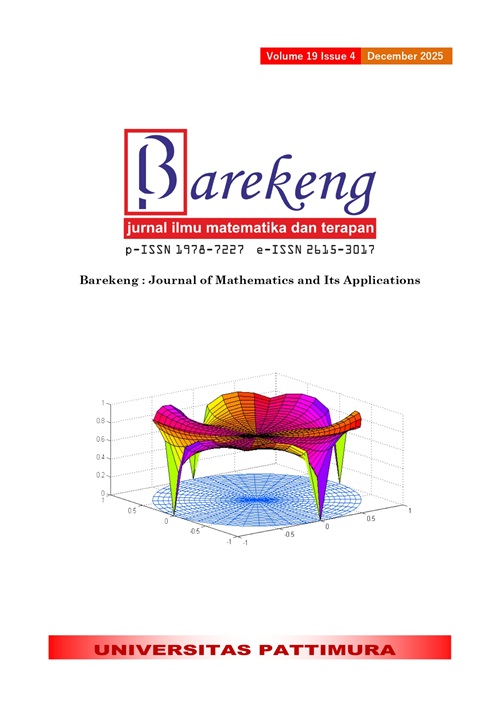COMPARISON OF SUPERVISED MACHINE LEARNING ALGORITHMS IN HEART FAILURE DISEASE
Abstract
The heart is a vital organ in the human body that functions to pump blood throughout the body and to the lungs. The heart is located in the chest cavity. The heart is the main force that drives human life. Therefore, if there is a disturbance in heart function, this can cause a decrease in quality of life to death, one of which is heart failure. Heart failure, if not diagnosed and treated quickly, will result in death. Based on findings showing the high death rate due to heart failure, a classification is needed to predict heart failure using machine learning methods. Machine learning can help predict this disease to improve early detection and more accurate medical decision-making. This study focuses on predicting the likelihood of a patient experiencing heart failure. The machine learning algorithm method used is supervised machine learning classification, including decision trees, random forests, naïve bayes, SVM, and K-NN. The results showed that the best method for predicting heart failure was Random Forest with an accuracy of 74.35%, followed by SVM with an accuracy of 69.23%. Meanwhile, Naïve Bayes had the lowest accuracy of 51.28%. Based on these findings, Random Forest is recommended as the best method for heart failure prediction due to its ability to handle data complexity and provide more stable results. Once the best algorithm is obtained, the prediction results and early detection of heart failure will be more accurate.
Downloads
References
I. M. Adhikara, “MENGENAL JANTUNG,” Direktorat Kajian dan Inovasi Akademik, 2024. [Online]. Available: https://mooc.ugm.ac.id/mengenal-jantung/#:~:text=Jantung%20adalah%20salah%20satu%20organ,seluruh%20tubuh%20dan%20paru%2Dparu.. [Accessed 19 November 2024].
D. Sitompul, R. Hamonangan, D. J. Ziegel and E. Indra, “PERBANDINGAN ALGORITMA K-NEAREST NEIGHBORS (K-NN) DAN RANDOM FOREST TERHADAP PENYAKIT GAGAL JANTUNG,” Jurnal Teknlogi Informatika dan Komputer MH. Thamrin, Vols. 9, no. 1, p. 471–486, 2023. Doi: https://doi.org/10.37012/jtik.v9i1.1432
WHO, “THE TOP 10 CAUSES OF DEATH,” 7 Agustus 2024. [Online]. Available: https://www.who.int/news-room/fact-sheets/detail/the-top-10-causes-of-death. [Accessed 18 November 2024].
Kemenkes, “SEHAT NEGERIKU,” 29 September 2022. [Online]. Available: https://sehatnegeriku.kemkes.go.id/baca/rilis-media/20220929/0541166/penyakit-jantung-penyebab-utama-kematian-kemenkes-perkuat-layanan-primer/. [Accessed 18 November 2024].
Kemenkes, “KEMENKES HEBAT, INDONESIA SEHAT,” 23 September 2024. [Online]. Available: https://kemkes.go.id/id/rilis-kesehatan/kenali-gejala-jantung-sejak-dini. [Accessed 18 November 2024].
A. Hartono, L. A. Dew, E. Yuniarti and S. T. H. Putri, “MACHINE LEARNING CLASSIFICATION FOR DETECTING HEART DISEASE WITH K-NN ALGORITHM, DECISION TREE AND RANDOM FOREST,” Eksakta: Berkala Ilmiah Bidang MIPA, vol. 24 NO 04, pp. 513-522, 2023.
T. A. E. Putri, T. Widiharih and R. Santoso, “PENERAPAN TUNING HYPERPARAMETER RANDOMSEARCHCV PADA ADAPTIVE BOOSTING UNTUK PREDIKSI KELANGSUNGAN HIDUP PASIEN GAGAL JANTUNG,” JURNAL GAUSSIAN, vol. 11, no. 3, pp. 397-406, 2022. Doi: https://doi.org/10.14710/j.gauss.11.3.397-406
M. R. Alfaqih, C. Indianti and A. Z. Abidin, “HUBUNGAN KLASIFIKASI HIPERTENSI DENGAN PENYAKIT JANTUNG KORONER DI POLI JANTUNG RSUD DR. R. SOSODORO DJATIKOESOEMO BOJONEGORO,” Jurnal Ilmiah Keperawatan (Scientific Journal of Nursing), vol. 10, no. 3, pp. 514-521, 2024. Doi: https://doi.org/10.33023/jikep.v10i3.2289
S. Y. Prasetyo, “PREDIKSI GAGAL JANTUNG MENGGUNAKAN ARTIFICIAL NEURAL NETWORK,” Jurnal Saintekom : Sains, Teknologi, Komputer dan Manajemen, vol. 13, no. 1, pp. 79-88, 2023. Doi: https://doi.org/10.33020/saintekom.v13i1.379
P. Purwono, P. Dewi, S. K. Wibisono and B. P. Dewa, “MODEL PREDIKSI OTOMATIS JENIS PENYAKIT HIPERTENSI DENGAN PEMANFAATAN ALGORITMA MACHINE LEARNING ARTIFICIAL NEURAL NETWORK,” INSECT, vol. 7, no. 2, pp. 82-90, 2022. Doi: https://doi.org/10.33506/insect.v7i2.1828
R. Pranandito and Hendry, “PERBANDINGAN PREDIKSI PENYAKIT SERANGAN JANTUNG MENGGUNAKAN MODEL MACHINE LEARNING,” JIPI (Jurnal Ilmiah Penelitian dan Pembelajaran Informatika) , vol. 8, no. 4, pp. 1228-1237, 2023. Doi: https://doi.org/10.29100/jipi.v8i4.4165
S. Adi and A. Wintarti, “KOMPARASI METODE SUPPORT VECTOR MACHINE (SVM), K-NEAREST NEIGHBORS (KNN), DAN RANDOM FOREST (RF) UNTUK PREDIKSI PENYAKIT GAGAL JANTUNG,” MATHunesa Jurnal Ilmiah Matematika , vol. 10, no. 2, pp. 258-269, 2022. Doi: https://doi.org/10.26740/mathunesa.v10n2.p258-268
I. Cholissodin, S. A. A. Soebroto, U. Hasanah and Y. I. Febiola, AI, MACHINE LEARNING & DEEP LEARNING (Teori & Implementasi), Malang: Fakultas Ilmu Komputer, 2020.
D. Shah, S. Patel and S. K. Bharti, “HEART DISEASE PREDICTION USING MACHINE LEARNING TECHNIQUES,” SN Computer Science, pp. 1-6, 2020.doi: https://doi.org/10.1007/s42979-020-00365-y
R. N. Romadhon, A. Ogi and A. P. Agung, “IMPLEMENTASI ALGORITMA DECISION TREE UNTUK KLASIFIKASI PELANGGAN,” Karimah Tauhid, vol. 3, no. 2, pp. 1860-1874, 2024.doi: https://doi.org/10.30997/karimahtauhid.v3i2.11952
C. Valsecchi, F. Grisoni, V. Consonni, D. Ballabio and R. Todeschini, MULTITASK LEARNING FOR QUANTITATIVE STRUCTURE–ACTIVITY RELATIONSHIPS: A TUTORIAL. In: Hong, H. (eds) Machine Learning and Deep Learning in Computational Toxicology. Computational Methods in Engineering & the Sciences, Cham: Springer, 2023.doi: https://doi.org/10.1007/978-3-031-20730-3_8
Z. Masetic and . A. Subasi, “CONGESTIVE HEART FAILURE DETECTION USING RANDOM FOREST CLASSIFIER,” Computer Methods and Programs in Biomedicine, 2016.doi: https://doi.org/10.1016/j.cmpb.2016.03.020
A. Das, "LOGISTIC REGRESSION." ENCYCLOPEDIA OF QUALITY OF LIFE AND WELL-BEING RESEARCH, CHAM: SPRINGER INTERNATIONAL PUBLISHING, 2024, pp. 3985-3986.doi: https://doi.org/10.1007/978-3-031-17299-1_1689
P. M. Fatima M., “SURVEY OF MACHINE LEARNING ALGORITHMS FOR DISEASE DIAGNOSTIC,” J Intell Learn Syst Application, vol. 9, pp. 1-16, 2017.doi: https://doi.org/10.4236/jilsa.2017.91001
B. Kim, “COMPARISON OF HEART FAILURE PREDICTION PERFORMANCE USING VARIOUS MACHINE LEARNING TECHNIQUES,” International Journal of Internet, Broadcasting and Communication, vol. 16(4), pp. 290-300, 2024.
M. K. Biddinika, A. Masitha, H. Herman and V. A. N. Fatimah, “MACHINE LEARNING TECHNIQUES FOR HEART DISEASE PREDICTION USING A MULTI-ALGORITHM APPROACH,” JUITA: Jurnal Informatika , vol. 12(2), pp. 149-158, 2024. Doi: https://doi.org/10.30595/juita.v12i2.24153
L. R. Safitri, N. Chamidah, T. Saifudin, M. Firmansyah and G. T. Alpandi, “COMPARISON OF LOGISTIC REGRESSION AND SUPPORT VECTOR MACHINE IN PREDICTING STROKE RISK,” INFERENSI, vol. 7, no. 2, pp. 123-128, July 2024.doi: https://doi.org/10.12962/j27213862.v7i2.20420
M. Hamza and D. Larocque, “AN EMPIRICAL COMPARISON OF ENSEMBLE METHODS BASED ON CLASSIFICATION TREES,” Journal of Statistical Computation and Simulation, vol. 75, no. 8, p. 629–643, August 2005.doi: https://doi.org/10.1080/00949650410001729472
A. Damayunita, R. S. Fuadi and C. Juliane, “COMPARATIVE ANALYSIS OF NAIVE BAYES, K-NEAREST NEIGHBORS (KNN), AND SUPPORT VECTOR MACHINE (SVM) ALGORITHMS FOR CLASSIFICATION OF HEART DISEASE PATIENTS,” JOIN (Jurnal Online Informatika, vol. 7, no. 2, pp. 219-225, 2022. doi: https://doi.org/10.15575/join.v7i2.919
F. S. Alotaibi, “IMPLEMENTATION OF MACHINE LEARNING MODEL TO PREDICT HEART FAILURE DISEASE,” (IJACSA) International Journal of Advanced Computer Science and Applications, Vols. Vol. 10, No. 6, pp. 261-268, 2019.doi: https://doi.org/10.14569/IJACSA.2019.0100637
S. Xu, Z. Zhang, D. Wang, J. Hu, X. Duan and T. Zhu, “CARDIOVASCULAR RISK PREDICTION METHOD BASED ON CFS SUBSET EVALUATION AND RANDOM FOREST CLASSIFICATION FRAMEWORK,” in 2017 IEEE 2nd International Conference on Big Data Analysis , Beijing, 2017.doi: https://doi.org/10.1109/ICBDA.2017.8078813
A. Rahmah, N. Sepriyanti, M. H. Zikri, I. Ambarani and M. Y. bin Shahar, “IMPLEMENTATION OF SUPPORT VECTOR MACHINE AND RANDOM FOREST FOR HEART FAILURE DISEASE CLASSIFICATION,” Public Research Journal of Engineering, Data Technology and Computer Science, vol. 1, no. 1, pp. 34-40, 2023. Doi: https://doi.org/10.57152/predatecs.v1i1.816
R. Baxani and M. Edinburgh, “Heart Disease Prediction Using Machine Learning Algorithms Logistic Regression, Support Vector Machine and Random Forest Classification Techniques,” SSRN, July 1, 2022. Doi: https://doi.org/10.2139/ssrn.4151423
U. K. Lilhore, P. Manoharan, J. K. Sandhu, S. Simaiya, S. Dalal, M. A. Baqasah, M. Alsafyani, R. Alroobaea, I. Keshta and K. Raahemifar, “HYBRID MODEL FOR PRECISE HEPATITIS-C CLASSIFICATION USING IMPROVED RANDOM FOREST AND SVM METHOD,” Scientifc Reports, Vols. vol. 13, no. 1, p. 1–18, 2023.doi: https://doi.org/10.1038/s41598-023-36605-3
Copyright (c) 2025 Jauhara Rana Budiani, Nur Mahmudah

This work is licensed under a Creative Commons Attribution-ShareAlike 4.0 International License.
Authors who publish with this Journal agree to the following terms:
- Author retain copyright and grant the journal right of first publication with the work simultaneously licensed under a creative commons attribution license that allow others to share the work within an acknowledgement of the work’s authorship and initial publication of this journal.
- Authors are able to enter into separate, additional contractual arrangement for the non-exclusive distribution of the journal’s published version of the work (e.g. acknowledgement of its initial publication in this journal).
- Authors are permitted and encouraged to post their work online (e.g. in institutional repositories or on their websites) prior to and during the submission process, as it can lead to productive exchanges, as well as earlier and greater citation of published works.






1.gif)



